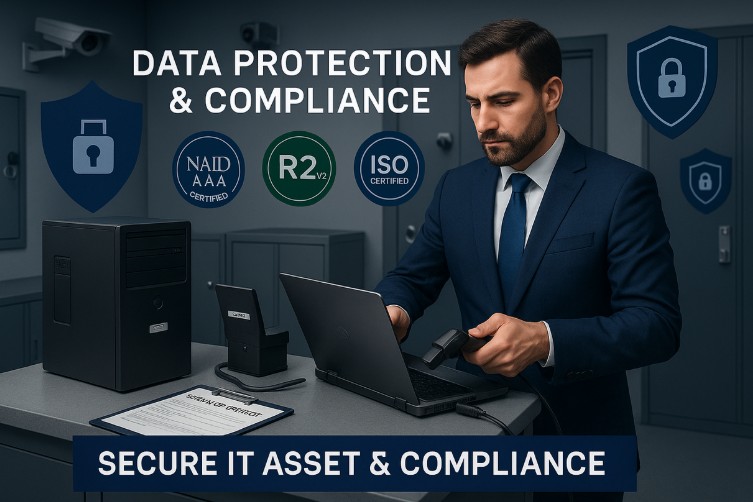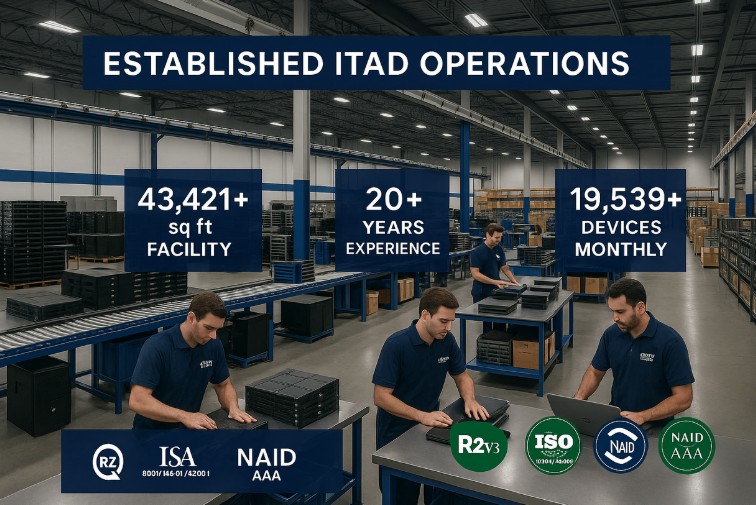In a world where a single data breach can cost a company an average of $4.45 million, the stakes for managing your company’s retired IT assets have never been higher. Forgetting about old laptops, servers, and hard drives isn’t just a storage problem it’s a multi-million-dollar liability waiting to happen. The global IT asset disposition (ITAD) market is projected to reach $54.54 billion by 2030, signaling that businesses worldwide are recognizing the urgent need for secure disposal strategies.
But where do you even begin when faced with storage rooms packed with outdated equipment and the complex web of regulations governing their disposal? The consequences of improper disposal extend far beyond simple compliance violations, potentially exposing organizations to data breaches, environmental liability, and significant financial penalties.
This comprehensive guide outlines the essential steps to create a secure and reliable IT asset disposal plan that protects your data, ensures regulatory compliance, and recovers hidden value from your old equipment.
IT Asset Inventory Assessment: First Step in Secure Disposal
A detailed inventory assessment forms the foundation of secure IT asset disposal and serves as the critical first step in protecting your organization from potential data breaches. This comprehensive process involves systematically cataloging every piece of hardware your organization owns, from enterprise servers and network equipment to employee mobile devices and peripheral storage media. Each asset should be meticulously tagged with unique identifiers, manufacturer serial numbers, current location data, assigned user information, and, most importantly, data sensitivity classifications that will determine the appropriate disposal methods.
According to Gartner, organizations with robust IT asset management practices can reduce their IT costs by up to 30% in the first year alone, making this initial step a security measure as well as a significant financial opportunity. The inventory process also reveals hidden assets that may have been forgotten in storage rooms or remote locations, preventing potential security vulnerabilities and compliance violations that could result in costly penalties.
Data Backup Before IT Disposal: Key Considerations
Before disposal, organizations must implement comprehensive data backup strategies to ensure business continuity. This systematic approach involves identifying, categorizing, and securely transferring all valuable data to appropriate storage systems.
Key backup considerations include:
- Data Classification: Identify business-critical versus routine information
- Retention Policies: Define storage duration for different data types
- Storage Location: Balance between cloud scalability and on-premises control
- Access Controls: Ensure only authorized personnel can access backed-up data
- Verification Processes: Confirm data integrity after backup completion
IT Data Sanitization Standards
Data sanitization permanently removes all information from storage devices in accordance with industry standards like NIST 800-88 Rev.1. Organizations must select appropriate methods based on data sensitivity and storage technology. For maximum security, partnering with a certified data destruction provider ensures compliance with recognized standards.
The three primary sanitization methods are:
- Data Erasure: Software-based overwriting, ideal for devices being reused or resold
- Degaussing: Magnetic field exposure that scrambles data beyond recovery
- Physical Destruction: Complete device shredding for the highest security requirements
How to Select a Certified ITAD Vendor for Secure Disposal
Choosing the right ITAD vendor is crucial for secure disposal and regulatory compliance. The vendor selection process requires careful evaluation of certifications, security protocols, and service capabilities.
Essential vendor certifications include:
- R2v3 Certification: Responsible recycling standard for environmentally safe handling
- NAID AAA Certification: Highest level data destruction certification
- ISO 14001: Environmental management systems demonstrating sustainability
- ISO 45001: Occupational health and safety, ensuring worker protection
- Chain of Custody Documentation: Complete tracking from pickup to disposition
For comprehensive asset management, consider a corporate IT asset disposition program that covers everything from data sanitization to value recovery.
IT Asset Disposal Compliance
Non-compliance with data protection and e-waste regulations can result in millions of dollars in fines and irreparable reputation damage. A survey found that more than half of all organizations faced regulatory compliance issues due to poor IT asset management, leading to substantial fines and legal risks in 2024.
Understanding key regulations is essential:
- GDPR: European Union data privacy requirements, including the right to be forgotten
- HIPAA: Healthcare organizations must ensure secure disposal of protected health information
- FACTA: Financial institutions are required to securely destroy consumer financial information
- RCRA: Federal law regulating hazardous waste disposal, including toxic electronic materials
Creating a Secure IT Asset Decommissioning Plan
Create a formal, written plan outlining every disposal step from initial request to final certificate. This comprehensive document should establish clear protocols to ensure consistency and minimize human error.
Essential plan components include: roles and responsibilities, timeline management, communication protocols, documentation requirements, and escalation procedures for addressing issues that may arise during the disposal process.
Establishing a Timeline for Disposal
Disposal timelines typically span 2 to 4 weeks, depending on asset volume and sanitization complexity. Include milestones for inventory completion, data backup verification, sanitization method selection, vendor coordination, and final documentation delivery. Build in buffer time for unexpected challenges and maintain regular progress reviews.
Stakeholder Engagement and Role Assignment in IT Asset Disposal
Successful disposal requires cross-functional engagement across multiple departments. Each stakeholder group brings unique expertise that must be coordinated throughout the disposal process.
Key stakeholder roles include:
- IT Management: Technical oversight of asset identification and data backup
- Information Security: Ensuring sanitization methods meet security standards
- Legal and Compliance: Verifying processes align with regulatory requirements
- Facilities Management: Coordinating physical asset removal and logistics
- Finance Teams: Evaluating value recovery opportunities and optimizing costs
Automating IT Asset Decommissioning Workflows
Automation streamlines processes and reduces human error by managing asset discovery, inventory tracking, and documentation generation. Modern IT asset management (ITAM) tools enable automated tracking that monitors asset status and triggers disposal workflows. Automation reduces processing time by 15-20% while improving accuracy and compliance documentation.
ITAD Documentation and Audit Trails for Compliance
Comprehensive documentation serves as the foundation of secure IT asset disposal programs, providing essential evidence of regulatory compliance and creating accountability throughout the disposal process. These records demonstrate proper data handling and establish an unbroken chain of custody.
Essential documentation includes:
- Asset Inventories: Detailed records with serial numbers and asset tags
- Data Classification Records: Documentation of information sensitivity levels
- Sanitization Certificates: Official verification of data destruction methods
- Transportation Manifests: Secure logistics tracking throughout disposal
- Final Disposition Reports: Complete records of asset destination and handling
Environmentally Responsible Recycling Practices
Environmental responsibility drives both regulatory compliance and corporate sustainability initiatives. Partner with certified e-waste recycling providers following R2v3 standards for proper hazardous material handling. Responsible recycling maximizes material recovery and supports circular economy principles while protecting organizations from environmental liability.
How Sustainable IT Disposal Improves Brand Reputation
Sustainable disposal practices enhance brand reputation and demonstrate corporate social responsibility. Communicate achievements through sustainability reports using concrete metrics, such as e-waste diverted from landfills and materials recovered, to provide evidence of environmental impact and organizational commitment.
Cost-Effective IT Asset Disposal Strategies
Effective programs improve cost efficiency through value recovery, reduced storage costs, and streamlined processes. Rather than viewing disposal as pure cost, organizations should approach it as a value recovery opportunity.
Cost optimization strategies include:
- Value Recovery Programs: Resale and refurbishment of assets with remaining market value
- Bulk Disposal Arrangements: Negotiated pricing with certified vendors
- Automated Workflow Implementation: Reduced manual processing and labor costs
- Storage Cost Reduction: Elimination of warehousing expenses for retired equipment
Integrating Disposal into IT Asset Lifecycle Management
Disposal must be integrated into a comprehensive IT asset lifecycle management strategy that spans from procurement to end-of-life. This holistic approach enhances operational efficiency and maximizes value recovery at every stage. Organizations with integrated strategies report up to 40% return on investment (ROI) through better asset utilization and more strategic disposal practices.
IT Disposal for Value Recovery and Environmental Impact
Secure IT asset disposal creates significant opportunities for both value recovery and environmental impact reduction. Companies with effective lifecycle management strategies see ROI improvements through cost savings and optimized decommissioning workflows.
Recycling one million laptops saves enough energy to power 3,500 U.S. homes for an entire year, demonstrating how responsible disposal practices contribute to both financial returns and environmental stewardship.
Build a Future-Ready ITAD Strategy with OEM Source
As IT infrastructure continues to evolve, so must your asset disposal approach. From data protection and compliance to cost recovery and sustainability, it’s clear that secure IT asset disposal continues to be a business-critical strategy.
Partner with OEM Source to implement a future-ready ITAD program that protects your organization, preserves your reputation, and maximizes the value of your retired assets.
Contact us today to learn how our certified, secure, and sustainable IT asset disposition services can support your organization’s regulatory goals and sustainability initiatives.
Frequently Asked Questions
What is the IT asset decommissioning process?
The IT asset decommissioning process is a formal, multi-step procedure for taking IT assets out of service. It involves inventory assessment, data backup, data sanitization, and secure disposal, all while ensuring data protection and regulatory compliance.
How do you handle the disposal of IT assets?
Disposal is handled through certified ITAD vendors that provide a secure chain of custody, data destruction certificates, and environmentally responsible recycling in line with industry regulations and sustainability standards.
What is decommissioning in information technology?
Decommissioning in IT refers to the retirement of hardware or software from active environments. It includes data backup, removal from networks, and preparing assets for secure and compliant disposal.
What does it mean to decommission an asset?
Decommissioning an asset means formally taking it out of service through a structured, secure process that protects against data breaches, compliance violations, and environmental risk.
Why is IT asset decommissioning important for compliance?
IT asset decommissioning plays a critical role in maintaining compliance with data protection laws like HIPAA, GDPR, and FACTA. Without a formal process in place, organizations risk regulatory penalties, legal exposure, and reputational damage.





